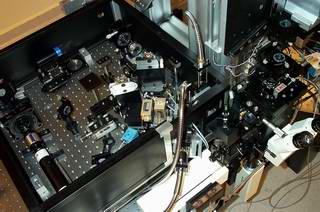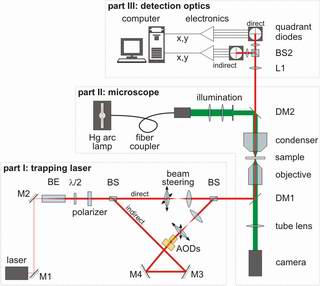Real-life μ-Tetris at the Vrije Universiteit — a bit more detailTo accomplish microTetris, we use the technique of optical trapping (explained elsewhere on our group's webpage) to hold the glass beads in place. In short, an optical trap is a laser beam which is focused to a very tiny spot (1 micrometer = about 1/1000th of a millimeter) by a strong lens, usually a microscope's objective lens. This focus appears to act as an attractor point, in which small particles like our 1-micrometer glass beads (but also cells or bacteria) can be sucked and from which they cannot escape. This tool, also more figuratively referred to as 'optical tweezers' is nowadays indispensable in biophysical research. It is being used to push cells together to monitor their elastic properties, or to stretch single molecules of DNA until the DNA helix unwinds or breaks, or to measure the forces of the 'motor' that propells bacteria through their surroundings. In fact, we could add a lot more things to this list without being complete. In our Tetris case, a device called an acousto-optic deflector (AOD) was
used to computer-steer the trapping laser light very swiftly across the 42
bead positions as seen in the video—pretty much like the way a monitor
steers its electron beam across the pixels on the screen. This was done
fast enough for a bead to stay at its location while the laser was
scanning the other positions. (At the end of the video, you can observe
what happens if we suddenly switch off the laser light: the beads are no
longer confined to their traps and can diffuse away easily.)
In our Tetris case, a device called an acousto-optic deflector (AOD) was
used to computer-steer the trapping laser light very swiftly across the 42
bead positions as seen in the video—pretty much like the way a monitor
steers its electron beam across the pixels on the screen. This was done
fast enough for a bead to stay at its location while the laser was
scanning the other positions. (At the end of the video, you can observe
what happens if we suddenly switch off the laser light: the beads are no
longer confined to their traps and can diffuse away easily.) All this equipment was readily available in our lab; the game of Tetris
was accomplished by writing a computer program for playing the game that
apart from that simultaneously drives the AOD. Therefore, the game was not
only played on the computer screen, but could also be followed through the
binoculars of our microscope (as seen in the videos).
All this equipment was readily available in our lab; the game of Tetris
was accomplished by writing a computer program for playing the game that
apart from that simultaneously drives the AOD. Therefore, the game was not
only played on the computer screen, but could also be followed through the
binoculars of our microscope (as seen in the videos).Our website has drawn the attention of a lot of Tetris lovers throughout the world. The most striking reaction we recieved was that from the president of the 'Harvard Tetris Society', who has conferred the honorable title of Master in their Society to us. Real-life μ-Tetris was created by Theodoor Pielage, Bram van den Broek and Joost van Mameren. Please send an e-mail to joost@ |